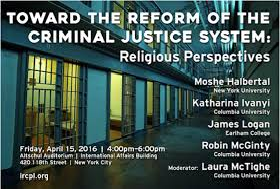Criminal Justice System and Biblical Perspective Order Instructions: “Competing for perspectives” in the criminal justice system are discussed, including certain “Biblical Perspectives,” one of which is restorative justice.

Restorative justice focuses on restoring the victim by making the offender compensate the victim for the wrong and adding some punishment. Numbers 5:6–7 highlights this principle very well. “Say to the Israelites: ‘When a man or woman wrongs another in any way[a]and so is unfaithful to the Lord, that person is guilty and must confess the sin he has committed. He must make full restitution for his wrong, add one fifth to it and give it all to the person he has wronged” (NIV1984). There is also a secondary emphasis on reintegrating offenders back into society.
The topic of this course is the Criminal Procedure. By nature, criminal procedure is “rights-based.” This is because much of the law comes from the Constitution, which was drafted to enumerate the powers of government. This limits government behavior to only those listed powers, but the Constitution also clearly lays out some rights (but not all) of states and citizens, particularly certain criminal procedure rights. As such, it can be said that criminal procedure focuses on the offender’s rights and government behavior.
Write a 275-word discussion forum on the following:
Based on your practical and educational experience, what is the focus of the criminal justice system, restorative justice, or criminal rights? Give specific examples.
Can these seemingly competing perspectives be better harmonized? Provide at least 1 reference and 1 scripture to support your answer.
Criminal Justice System and Biblical Perspective Sample Answer
There are varied competing perspectives in criminal justice system aimed at crime deterrence (Zehr, 2014). For instance, there three main approaches that can be adopted in a criminal procedure such as the criminal justice system, restorative justice, or criminal rights (Van Ness, 2013). In the criminal justice system process, the crime committed by the offender is deemed to be an act against the State, which is, violating a law or an abstract idea (Zehr, 2014). As a result, through this retributive criminal justice system perspective, the crime is controlled by the criminal justice system whereby the accountability of offenders is defined through the punishment they take. According to Zehr (2014) in this approach, there is no reconciliation between the offender and victim because the punishment is believed to be effective in deterring crimes through behavioral change. A good example is the conviction of an individual on public funds embezzlement or corruption, which through this approach the offender is only jailed or fined while the victim or community do no recover the embezzled funds.
Alternatively, restorative justice focuses on the needs of the victims or involved the community and the offenders rather than punishing of the offender or satisfying abstract legal principles (Vanfraechem, 2012; Woolpert, 2015). As a result, restorative justice offers an alternative to a criminal trial to ensure that all parties to the crime are central to solving the issue. The principle of restorative justice is highlighted in (1 Cor. 5:1-8 and Matt. 18: 15-18) where the punishment of offenders in a church is accomplished through hi/her excommunication, whereby the offender is expelled by the church from its fellowship whom may eventually repent and be united to the church. For example, a church member who steals is excommunicated but upon returning the stolen money/property and repenting is accepted back to church.
Furthermore, criminal rights must also can be considered in a criminal procedure based on the bill of rights since most laws are entrenched in the Constitution which enumerates the powers of governments while also specifying the limits of those powers and government behavior. As a result, criminal procedure focuses on government behavior and offender’s rights. A specific example is that an offender cannot continue to be held in cells for a billable crime and also every offender has the right to be represented by a lawyer (Zehr, 2014). These competing perspectives can be harmonized and are important in crime prevention/deterrence, intervention as well as breaking the cycle of crime through appropriate considerations of the State laws, punishment, and individual and social dimensions responsibility of crime in disrupting good relationships as well as community harmony.
Criminal Justice System and Biblical Perspective References
Vanfraechem, I. et al. (Ed.) (2012). Restorative Justice Realities. Empirical Research in a European context. Leuven, Belgium: eleven international publishing.
Van Ness, D.W. (2013). Restorative justice. In B. Galaway, & J. Hudson (Eds.), Criminal justice, restitution, and reconciliation. New York: Willow Tree Press, Inc.
Woolpert, S. (2015). Victim-offender reconciliation programs. In K.G. Duffy, et al. (Eds.), Community mediation: A handbook for practitioners and researchers. New York: The Guilford Press.
Zehr, H. (2014). Changing lenses: A new focus for crime and justice. Waterloo, Ontario: Herald Press.




